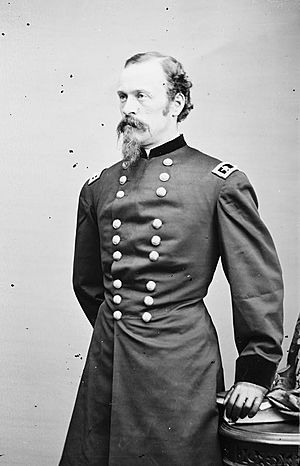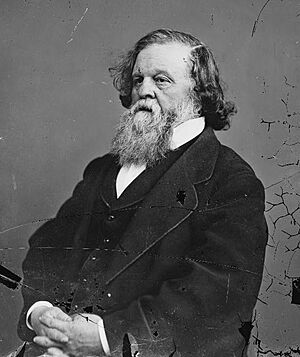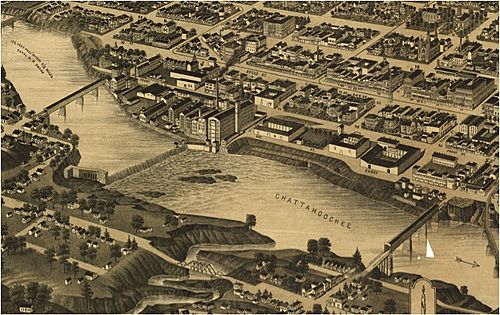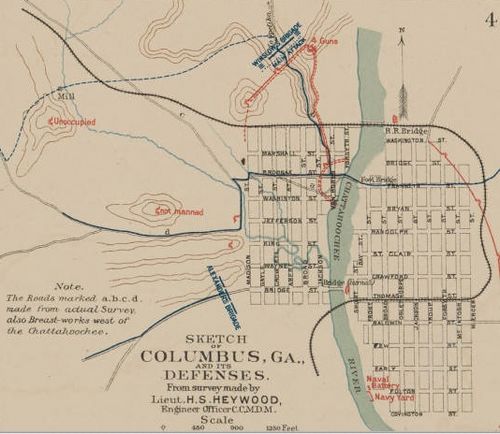Battle of Columbus (1865) facts for kids
Quick facts for kids Battle of Columbus |
|||||||
|---|---|---|---|---|---|---|---|
| Part of the American Civil War | |||||||
|
|||||||
| Belligerents | |||||||
| Commanders and leaders | |||||||
| Major General James H. Wilson | Major General Howell Cobb General Robert Toombs |
||||||
| Strength | |||||||
| Two cavalry divisions (9,000 cavalry) |
3,250 | ||||||
| Casualties and losses | |||||||
| 60 | 151 | ||||||
The Battle of Columbus, Georgia, happened on April 16, 1865. It was one of the last big fights in the American Civil War. This battle was part of a large Union Army movement called Wilson's Raid. This raid aimed to destroy important Confederate supply centers.
Major General James H. Wilson led the Union forces. His mission was to destroy Columbus. Columbus was a key city for the Confederacy. It made many supplies for the war. During the battle, there was a lot of confusion in the dark. Soldiers from both sides ended up on the same bridge. The Confederate cannons did not fire because of this. The next morning, Wilson's troops took over the city. They destroyed many things and captured many prisoners.
Some people say the Battle of Columbus was the very last battle of the Civil War. Others point to the Battle of Palmito Ranch. That battle happened after the main Confederate army had already given up. The Battle of Columbus is also sometimes called the Battle of Girard, Alabama. Girard is now known as Phenix City.
Contents
Why the Battle Happened

After the Union won the Battle of Nashville in December 1864, General George H. Thomas gave an order. He told Major General James H. Wilson to go deep into the South. Wilson's job was to destroy major Confederate supply centers. These centers were in Selma, Alabama, and Columbus, Georgia.
Wilson started his raid from Gravelly Springs, Alabama, on March 22, 1865. He headed for Selma first. Selma was a big manufacturing and supply hub. The Battle of Selma took place on April 2, 1865. Union troops greatly outnumbered the Confederates there. The Confederate capital of Richmond also fell on the same day. Wilson's raiders broke through Selma's defenses. They captured the city by 7 p.m. Wilson's men then destroyed all military supplies. They also looted the city before moving on.
On April 9, 1865, General Robert E. Lee surrendered his army. This happened at Appomattox Court House. But other Confederate armies were still fighting. General Wilson did not know about Lee's surrender yet. So, he kept going with his raid.
On April 12, 1865, Wilson's men marched into Montgomery, Alabama. This city used to be the Confederate capital. They met little resistance there.
Wilson's next target was Columbus, Georgia. It was the biggest supply city left in the South. Columbus was second only to Richmond in making war supplies. Richmond had already been captured. Columbus was on the Chattahoochee River. It had a major naval construction site. A new ironclad ship, the CSS Muscogee, was there. It was waiting to be finished.
President Abraham Lincoln was shot on April 14. He died the next day. But General Wilson did not know about this yet.
Columbus Gets Ready to Fight
The Confederates in Columbus knew Wilson's army was coming. They had about 13,000 soldiers. Confederate Major General Howell Cobb was in charge of defending Columbus. He gathered all the forces he could find.
Cobb had about 3,500 men. Most of them were local home guard units. They were also civilian volunteers from Georgia and Alabama. On April 16, 1865, Columbus newspapers warned people to leave the town. They said a Union attack was coming soon. The newspaper told everyone: "The enemy is coming fast. But Columbus will be defended to the end. We believe the city will be shelled. So, all people who are not fighting should leave right away."
General Cobb's Defense Plan

General Cobb decided to defend Columbus from the western side of the Chattahoochee River. This was in the town of Girard. Girard is now called Phenix City. The Confederates used trenches and breastworks. They also used earthen forts. These had been partly built earlier in the war. Now, they had to be finished quickly.
The main goal was to protect the two covered bridges. These bridges connected Girard to Columbus. Cobb knew Wilson's troops would have to cross these narrow bridges. This gave Cobb an advantage. Cobb also wanted to keep the high ground in Girard. If Wilson took it, he could easily fire cannons at Columbus.
Cobb prepared strong defenses on the high ground in Girard. He also ordered the bridges to be covered in cotton. This cotton was then soaked with turpentine. If the Confederates could not stop Wilson's raiders, they could burn the bridges. This would stop Union troops from getting into Columbus easily.
The bridges were designed by Horace King. He was a master builder. King was born into slavery in 1807. But he worked hard and earned his freedom. He became one of the most respected bridge builders in the South. People called him Horace "The Bridge Builder" King. After the Civil War, he became a legislator in Alabama.
The Battle Begins
On Easter, April 16, 1865, Wilson's raiders arrived at Girard. It was between 1:30 and 2 p.m. The fighting began. Wilson also sent some troops north of Columbus. They went to West Point, Georgia. Their goal was to cross the Chattahoochee River there. West Point was defended by Fort Tyler. The Battle of West Point and the Battle of Columbus happened on the same day.
Around 2 p.m., Union General Emory Upton's division attacked the lower bridge. They met little resistance at first. They thought they could cross easily. Upton even said, "Columbus is ours without a shot being fired." But it was a trap. Confederates had removed planks on the east side of the bridge. This was to stop the Union soldiers. It would also let the Confederates burn the bridge with soldiers on it. Upton saw the danger and had to retreat. It looked like the Confederates might be able to defend Columbus.
Wilson then focused on the upper bridge.
As the sun set, Confederate General Robert Toombs sent a telegram. He told Georgia Governor Joseph E. Brown about the fight. He expected a "decided fight" the next day. But General Wilson surprised him. Wilson launched an attack on the upper bridge at 8 p.m., after dark. He ordered General Winslow's brigade to lead the attack. Colonel Frederick Benteen was told to lead the charge. He later served under Custer at the Battle of Little Big Horn.
A big clash happened near the upper bridge entrance. Confederate John Pemberton was injured by a sword.
Around 10 p.m., the Confederate defenses in Girard broke down. They tried to retreat across the Chattahoochee River into Georgia. At the same time, Winslow's brigade wanted to cross the upper bridge. They feared it would be set on fire. Union and Confederate soldiers raced across the bridge together. It was too dark to tell who was who. Confederates tried to burn the bridge. But they did not want to harm their own troops.
General Robert Toombs had two cannons on the Georgia side of the upper bridge. They were loaded with special ammunition. They were aimed to hit anyone coming through the bridge. But Toombs held his fire. He knew soldiers on the bridge were a mix of both sides.
At 11 p.m., Wilson crossed the bridge. His horse was shot while crossing and later died. On the Columbus side, Wilson set up his headquarters. It was in the Mott House (Columbus, Georgia), the house closest to the bridge. Colonel C. A. L. Lamar led a cavalry charge there. Lamar was killed after refusing to surrender. General William Tecumseh Sherman wrongly said Lamar was the last Confederate to die in the Civil War.
The Day After the Battle
On the morning of April 17, 1865, General Wilson gave orders. All resources in Columbus that helped the Confederate war effort had to be destroyed. The ironclad ship CSS Muscogee was burned and sunk. The Confederate naval facility, Port Columbus, was completely destroyed. Confederates also sank the CSS Chattahoochee. They did this to stop it from falling into Union hands.
Hospital records show that more soldiers were hurt than first reported. General Wilson first said 25 Union soldiers were hurt. But the actual number was 60. Ten men were killed in battle. Eight more died later from their wounds. Most of these men are buried in Andersonville National Cemetery. The Confederates had 151 casualties. Many are buried in Linwood Cemetery in Columbus. About 1,600 Confederate prisoners were captured. They were held in a temporary Union prison camp.
The Union army completely destroyed Confederate factories. This happened in both Columbus, Georgia, and Girard (now Phenix City), Alabama. There was also a lot of damage on both sides of the Chattahoochee River. For days after the battle, fires burned warehouses and factories. This showed the war was ending. Union cavalry left Columbus on April 18.
On to Macon and Capturing Key Figures
After winning in Columbus, Wilson led his raiders east. They went to Macon, Georgia. They took over that city without a fight. Ten days after the Battle of Columbus, the last large Confederate army surrendered. This was General Joseph E. Johnston's army. It surrendered at Bennett Place, North Carolina. The American Civil War was finally over.
In early May, Wilson's men captured two of the most wanted men in America. They were Jefferson Davis, the president of the Confederacy. And Captain Henry Wirz, who was in charge of the Confederate prison at Andersonville.
Was Columbus the Last Battle?
Many sources have said that the Battle of Columbus was the last battle of the Civil War. In 1935, the state of Georgia said it was the "last battle of the war between the states." They wanted to create a national battlefield park there.
Most Confederates surrendered on April 26, 1865. This happened at Bennett Place, North Carolina. Many state governments saw this as the end of the war. If so, the Battle of Columbus was the last major battle. President Andrew Johnson declared the war over on May 10, 1865. This was the day President Jefferson Davis was captured. Johnson said any remaining fighters were no longer soldiers.
The Battle of Palmito Ranch happened on May 13. Some people claim this was the last battle. They do not agree with President Johnson's definition. They say the Confederates there were still "organized forces."
The Union officers who fought in Columbus believed it was the last battle. On May 30, 1865, General Emory Upton wrote a report. He said the Battle of Columbus was the "closing conflict of the war." In 1868, General Wilson gave a speech. He said that "the last battle had been fought." In 1913, Wilson wrote that there was "no doubt that 'Columbus was the last battle of the war.'" General Edward F. Winslow also believed it was the final battle. Colonel Theodore Allen said there were smaller fights after Columbus. But he felt they were not big enough to be called battles.
There was a movement to make the Columbus battlefield a national park. This effort lasted from the 1890s to the 1930s. But the director of the National Park Service rejected the idea in 1934. In response, Georgia passed a resolution in 1935. It called the battle the last of the Civil War. It asked again for a national battlefield park.
In recent years, some people have started new efforts. They want to remember the battlefield as a park. In 2013, Auburn University asked for help. They wanted to save Ft. Gilmer. This was one of the old forts on the Alabama side of the river.
In 2015, a professor named Virginia Causey wrote about the "last battle" idea. She suggested it was based on a myth. This was according to a report from 1934. But Daniel Bellware disagreed in his article. He said the report had many mistakes. He also questioned if the report was truly from the Department of the Interior. Bellware suggested calling Columbus "the last major military engagement of the Civil War." This avoids arguments about what counts as a "battle."
Images for kids
-
The route General James H. Wilson's troops took on the raid that passed through Columbus, Georgia
-
Confederate John Stith Pemberton was injured by a sword in the Battle of Columbus. His wound was said to contribute to his formulation of the recipe for the soda drink Coca-Cola.







